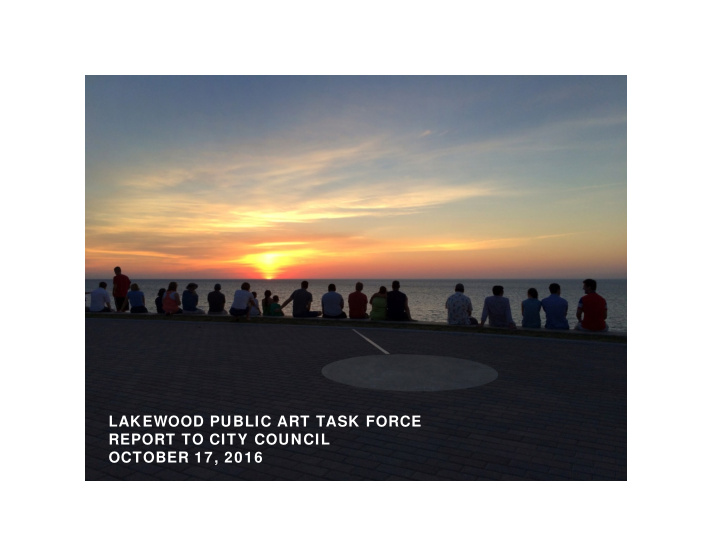



LAKEWOOD PUBLIC ART TASK FORCE REPORT TO CITY COUNCIL OCTOBER 17, 2016
3 years - 43,000 People – 26 Cities Soul of the Community , The Knight Foundation & Gallup What attaches people to a community and makes them w ant to put dow n roots? Jobs? the Economy? Safety?
3 years - 43,000 People – 26 Cities Soul of the Community , The Knight Foundation & Gallup SOCIAL OFFERINGS Places for people to meet and foster the feeling that people in the community care about each other OPENNESS How w elcoming the community is to different types of people including families w ith young children, minorities, and college graduates AESTHETICS The physical beauty of the community including the availability of parks, greenspace, and cultural offerings
Cities around the country are investing in the arts and placemaking activities to improve quality of life, remain competitive, and attract/retain residents
PROCESS 1) The City of Lakewood solicited applications from residents to serve on a Public Art Task Force 2) Six residents w ith backgrounds and professional interests in the arts w ere selected to serve on this task force. 3) The Public Art Task Force met betw een December 2015 – September 2016 to make recommendations on a strategic direction for public art throughout the City of Lakewood.
PROCESS 1) Review of existing public art collection 2) Survey of precedent cities and projects 3) Review other public art programs 4) Public information session w ith artists & interested community members 5) Creation of survey 6) Develop recommendations
MISSION for the task force: To create a sustainable plan and process bridging art and community in Lakewood's public spaces.
VISION for an art program that is: 1) Non-judgmental 2) Understanding 3) Responsive
KEY OPPORTUNITIES What are strategic public art investments the City of Lakewood can make to increase its value as a place that attracts residents, entrepreneurs, employees, and entertainment offerings?
ARCHITECTURAL LIGHTING PROGRAM
MURALS
WAYFINDING
NEIGHBORHOOD PARKS 1) Kids Cove 2) Kaufman Park 3) Cove Park 4) Wagar Park
RECOMMENDATION #1 CREATE A PUBLIC ART COMMITTEE To ensure that public art projects in Lakewood are designed, installed, and promoted at a high level, a Public Art Committee should be formed. This committee would review potential project locations, determine goals of artwork, engage w ith local artists, and make recommendations for artists and/or artworks to be commissioned by the City of Lakewood.
RECOMMENDATION #2 DETERMINE GOALS & STRATEGIES FOR PUBLICLY COMMISSIONED PROJECTS VS. PRIVATELY COMMISSIONED PROJECTS IN PUBLIC SPACES Promote a local culture that supports public art and artists. Create policies that allow for publicly funded projects to be developed in a w ay that meets broader goals of the City of Lakewood. Determine if/how City Hall can help promote public art projects that are commissioned by residents, business ow ners, and/or nonprofit organizations.
RECOMMENDATION #3 IDENTIFY SOURCE(S) OF FUNDING FOR PUBLICLY COMMISSIONED PROJECTS Other cities use sources such as Percent for Art program, a percentage of the City’s general fund, bed tax, and philanthropic partnerships, among others.
RECOMMENDATION #4 MAKE IT SOMEBODY’S JOB In order to have impact, a public art program should not rely on volunteers for its success. This position could become a staff role in City Hall, outsourced to an independent contractor or nonprofit partner, or added to the job description of an existing position in City Hall.
RECOMMENDATION #5 IDENTIFY PRIORITY PROJECTS Develop a strategic plan for public art projects that the City would like to see completed. When investment or development in adjacent areas take place, including art w ithin the broader project can be a w ay of getting them done. Funders like to see plans for broad initiatives, not one-off projects. City Hall can set the priorities and engage help from community partners by encouraging buy-in and participation early on.
RECOMMENDATION #6 BALANCE LAKEWOOD’S ART COLLECTION THROUGH A COMBINATION OF PERMANENT, TEMPORARY, AND PROGRAMMATIC ARTS INVESTMENTS Permanence is not the only measure of success. Temporary projects can help enliven districts and encourage additional projects. Programming is an important tool for activating spaces once the City has decided they are worth investing in (e.g., new parks, Madison Avenue)
RECOMMENDATION #7 HELP BUILD CAPACITY OF LOCAL ARTISTS Many cities w ant to engage local artists in their public art programs. In order to make local artists competitive and capable of delivering larger projects in a public setting, the City of Lakewood can partner w ith existing arts organizations to provide learning opportunities for artists.
RECOMMENDATION #8 START SMALL Select a project to do—and do it! Learn the process and make changes for the future. Invest limited funds strategically. Do not try to do everything all at once.
RECOMMENDATION #9 BUILD OFF OF EXISTING CULTURAL ASSETS Ethnic groceries – are places that not only sell Indian, Burmese, Nepali and other South Asian groceries but also places w here immigrants can congregate and share new s. Small eateries offering a range of global cuisines Lakewood Public Library The Beck Center for the Arts Cultural events in the parks Community Gardens and farm markets Bike friendly roads
NEXT STEPS: * City Council provides feedback * Telling the Lakewood story Lakewood’s cultural assets w ill help to secure funding for public art from government and foundation agencies. Potential government funders include the Ohio Arts Council, Cuyahoga Arts and Culture, and the National Endow ment for the Arts. Lakewood’s cultural assets reflect the diversity of the community – both emerging and existing. Public art that draw s attention to the confluence of all of these assets could make attractive public-private proposals.
THANK YOU!
Recommend
More recommend